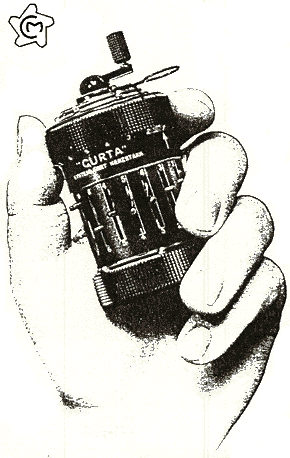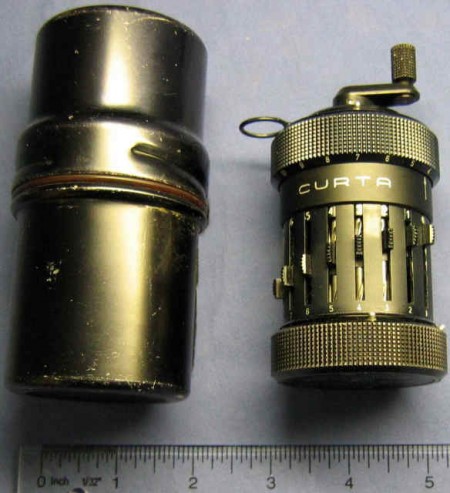Amazing Kurt

Perhaps no calculator of any type has caused as much discussion as Kurt. Although an entire book can be written about this incredible device and its creator, only a small amount of information is given in this article.
What is this device? Kurt looks like a small metal pepper pot or a coffee grinder. In fact, it is an exact tool that performs calculations mechanically and does not contain any electronic parts. The most similar sensation from the rotation of the lever Kurt, perhaps, will be the sensation from the rotation of the lens of a high-quality 35 mm camera. As far as is known, it is the smallest mechanical computer ever built.

')
The inventor of this device is Kurt Herzstark from Austria. For many years it was rumored that Herzstark secretly engaged in the development of Kurta during his imprisonment in a German concentration camp. Obviously, this is almost true. Herzstark was indeed a prisoner of Buchenwald, but the camp leaders knew about his work and encouraged her. Obviously, they wanted to present the invention to the Führer as a gift by the end of the war. Herzstark was given a drawing board, behind which he worked day and night on the device. The camp was liberated by the Americans in April 1945. Herzstark survived, as did his revolutionary invention - a miniature calculator.
Although several prototypes were created, the first production was launched in April 1947. The last Kurt was made in November 1970, but they were still sold before the beginning of 1973. By that time, the price of handheld electronic calculators had dropped to below $ 100, and such an accurate mechanical tool as Kurt could no longer compete with them.
Two different Kurt models were produced: Kurt I and Kurt II. The latter was slightly larger (53 mm in diameter versus 35 mm in Kurta I). For the first time Kurt II was put into production in 1954 and had an increased number of digital registers compared to Kurt I.

What was the pace of production? In 1949, only 300 Kurt could be produced per month, whereas by 1952 the output of finished products was already about 1000 units per month. For 20 years, about 80 thousand copies of the Kurt I model and about 60 thousand copies of the Kurt II model were produced.
Kurt was a precise instrument, and therefore sold with a protective capsule or case. These were winding cylinders, often with a seal inside. Plastic capsules were also produced for some time, but they were considered unsuitable, production was curtailed, and metal cases began to prevail again. Prince Heinrich von Lichtenstein, obviously, found the metal case too rigid for such an accurate instrument, so a special leather case was created especially for his Kurt.
Why does the Kurta protective capsule cap twist in the opposite direction (counterclockwise)? This was done partly in order to prevent the instrument from falling onto the floor when the lid was opened sharply, and partly to prevent Kurty from accidentally turning the operating lever when the lid was tightened. In this case, Kurt was not ready for calculations when the case was reopened. Obviously, early metal cases with a clockwise lid are very rare.
For sweetness - Kurt in action: ( watch video )
Related Links:
1. Kurt Disassembled
2. Original advertising brochure
3. Article on RetroCalculators.com
4. Article on the HP Museum website
5. Algorithms that can be run on Kurt
6. Simulator Kurt on Flash
(for 5-6 thanks to Kavu )
Source: https://habr.com/ru/post/31415/
All Articles